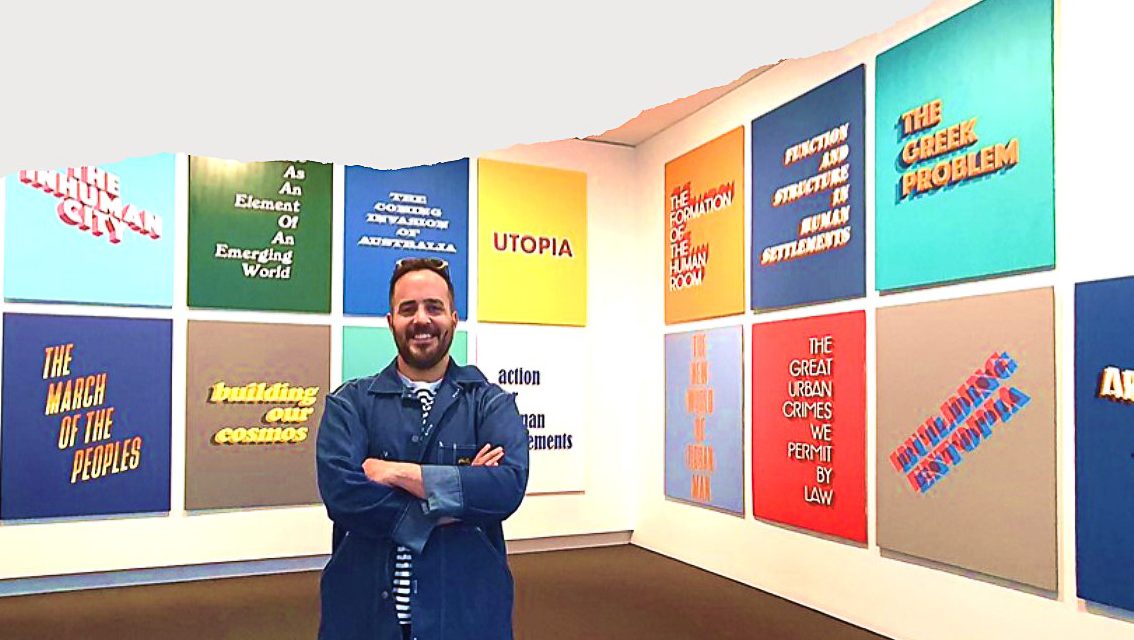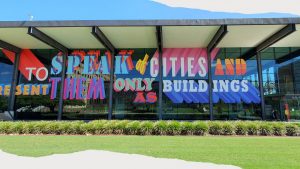I was at a loose end a few months ago, and my partner suggested I get out of the house and visit an art gallery.
I had never been to the UQ Art Museum so I decided to get a CityCat across the river to see what I could find. Both of the exhibitions I was able to see that day were superb but one in particular grabbed my attention. It was a work by Brisbane artist Sam Cranstoun: To Speak of Cities.
Sam Cranstoun took the title for his exhibition from an essay by Constantinos Apostolou Doxiadis, a Greek town planner, architect, and engineer.
The exhibition not only celebrates the prescience of Doxiadis’ vision and his explorations of ‘the city’, but also exposes the shameful way Australia often treats its immigrants, and in so doing, forfeits the benefits of their expertise and creativity.
The story and the exhibition also reveals something of a mystery.
Doxiadis, the author of books with evocative titles such as “Between Dystopia and Utopia” and “Guide to the City of the Future”, and the designer of Islamabad – the capital city of Pakistan – lived in Highgate Hill and Rochedale in the 1950s. But he did not work as a planner here, he grew tomatoes.
In his work, Sam Cranstoun focusses on history, historical figures and events, and he heard about Doxiadis through a friend.
“Often people come to me and say, ‘oh, you know I found out about this person – you’ll find this interesting’, and sometimes they’re right, sometimes not so much.”
“But fortunately, on this particular occasion, a friend of mine said, ‘You know, I know about this man. A Greek town planner who moved to Brisbane in the 1950s.’”
Sam says, according to his friend, Doxiadis worked in Brisbane as an architect and designed buildings, so Sam investigated. He found no records of Doxiadis having worked as a planner or architect in Australia but, by chance, he discovered that Doxiadis had a son who was alive and working as a writer in Athens.
“On his Wikipedia page, there was just a little line that says, ‘born in Brisbane, Australia in 1953’. So, I knew I was on the right track, and from there I got in touch with his archives. He died in the 70s, but his archives are held in Athens still – I just kind of went from there.”
Sam worked on the project for some years. He first followed the trail by travelling to Greece at the end of 2016. Sam says the Doxiadis Archivist had such detailed knowledge of the collection she was immediately able to point him to the materials related to Doxiadis’ time in Australia.
“A lot of people visit these archives to have a look at the work that he did in Pakistan or the work he did in the Middle East or in Africa and America. I was just saying, ‘Hey, can you show me the tomato seed packets from the Stones Corner hardware store please? Receipts from his farming work?’”
“There’s still so much about it that lingers and looms large in my mind,” Sam told me.
He said he spoke with Doxiadis’ now 70-year-old daughter who lives in Corfu.
“She remembers Australia. She remembers her time in Brisbane. She remembers going to Somerville House.”
After leaving Australia, and before eventually founding his university in Athens, Doxiadis developed a system of town planning theory known as Ekistics: the science of human settlements and systems.
But this is the story of a migrant whose potential Australia ignored.
In the archive, Sam found an article reporting a speech given in Adelaide by then Prime Minister John Gorton. It is dated 1969.
In it, Gorton laments that Australia “had failed to use the genius of a Greek Migrant“. He says Doxiadis is an example of Australia’s “deeply ingrained conservatism”.
Gorton noted that after growing tomatoes in Australia, Doxiadis returned to Athens, where he founded a university, and began town planning in Greece, Philadelphia, Washington, Louisville, the Middle East, Asia, and the United Kingdom.
“I would like to think that if Dr Doxiadis were to come as a migrant now, with our growing sophistication, and our recognition of the need for advanced managerial skills, he would not be rejected,” Gorton is recorded as saying.
Sadly, some 50 years later, the experiences of migrants is often little different to that experienced by Doxiadis.
“There are many more people than this one individual who we can point to, but we know his story because of what he went on to achieve,” Sam said.
“There is that element then about how much it is continuing to happen now – it isn’t a finished thing. It’s not something that has been entirely resolved. It’s not something that we have gotten on top of. It’s such an overwhelmingly saddening thing.”
Languages or language difficulties are often offered as the reason highly qualified migrants do not secure jobs and recognition in Australia. But Doxiadis spoke good English and wrote many of his texts in English too.
“It’s about the other. It’s about what’s unfamiliar to us. It is easy to discount and easy to marginalise and casually poke fun and dismiss because that person has a name that I can’t quite easily say – it’s as simple as that,” Sam said.
Sam considers Doxiadis as a kind of “stand-in” for all the other stories about marginalised migrants.
“Doxiadis went on to achieve so much, so you can kind of point to how poorly he was treated, whereas a lot of other people didn’t have that moment of redemption, or validation. And so, I think a lot of people can look at this and say, ‘yes, I know this is what everyone who experienced this deserves’, this sort of moment of redemption.”
Sam says that it took him about five years after finding out about Doxiadis to make his artwork.
Exhibition in two parts.
The first is a drawing of Doxiadis in his Australian greenhouse.
“Part of that five-year process was very much about researching him, thinking about his body of work, the contributions that he had made to history, and thinking about how I wanted to approach those things. What struck me were the images of him – you can think of him in his greenhouse.”
The larger and central part of the exhibition is a series of vibrantly coloured paintings containing text taken from the titles of Doxiadis books, essays, textbooks, and journal articles.
“These text works – these micro-poems have resonated so strongly with me, so viscerally,” Sam said.
“Much like his story being a kind of stand-in for other people’s stories, these titles have this renewed relevance, this sort of renewed life existing in this new context. So, for me, it just felt like they were hauntingly prescient.”
Titles like “The great urban crimes we permit by law“ would resonate with many living in West End.
“That is the one that, for me, I think sticks out most, and that relates so much. I think it resonates so much in the city of Brisbane because that’s what has been done to the face of this city in the name of profit or convenience.”
Sam says his work is the culmination of many interests, from the significance of the two world wars and how they shaped the international community, and his interest in architecture.
“That’s always been something I’ve been drawn to: how architecture can dictate the way someone lives their life, the way they occupy, not only a building, not only a room, but also a city.”
“I’ve had this intense fascination with how history always feels untouchable, out of reach: contemporary mythology. And, through certain work that I’ve done, it’s become apparent that you can interact with these things. Being able to track down Doxiadis’ daughter and speak to her about this man or talk to a friend of mine who’s whose grandmother in Highgate Hill knew him.”
“This is something that is living and breathing”.
Sam said the aesthetic and design choices for his work focused on making them honour the striking content of Doxiadis’ writing.
“So, I decided to depict them using the styles that would have been taken from textbooks and book covers from the time. But also, because while he was here in Australia, he was forced to farm tomatoes in order to support his family. So, I wanted to make a work that looked like they could have been on the side of fruit boxes. And so, they quite deliberately borrow from that fruit box design.”
The Gallery has purchased the work, but it is not currently on display.
“For me it was really important that they all stayed together. That was really significant and important,” Sam said.
Sam Cranstoun’s To Speak of Cities exhibition and front window commission were shown at UQ Art Museum in 2020 and early 2021.
Let’s hope the gallery brings this work out of wraps again soon.





